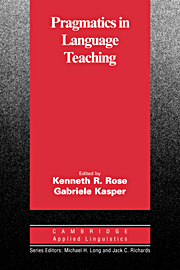Book contents
- Frontmatter
- Contents
- List of contributors
- Series editors' preface
- Preface
- Chapter 1 Pragmatics in language teaching
- I THEORETICAL AND EMPIRICAL BACKGROUND
- II ISSUES IN CLASSROOM-BASED LEARNING OF PRAGMATICS
- Chapter 4 Pragmatic and grammatical awareness: A function of the learning environment?
- Chapter 5 Why can't learners of JFL distinguish polite from impolite speech styles?
- Chapter 6 A longitudinal study of the development of expression of alignment in Japanese as a foreign language
- III THE EFFECTS OF INSTRUCTION IN PRAGMATICS
- IV THE ASSESSMENT OF PRAGMATIC ABILITY
- References
- Name index
- Subject index
Chapter 6 - A longitudinal study of the development of expression of alignment in Japanese as a foreign language
Published online by Cambridge University Press: 05 October 2012
- Frontmatter
- Contents
- List of contributors
- Series editors' preface
- Preface
- Chapter 1 Pragmatics in language teaching
- I THEORETICAL AND EMPIRICAL BACKGROUND
- II ISSUES IN CLASSROOM-BASED LEARNING OF PRAGMATICS
- Chapter 4 Pragmatic and grammatical awareness: A function of the learning environment?
- Chapter 5 Why can't learners of JFL distinguish polite from impolite speech styles?
- Chapter 6 A longitudinal study of the development of expression of alignment in Japanese as a foreign language
- III THE EFFECTS OF INSTRUCTION IN PRAGMATICS
- IV THE ASSESSMENT OF PRAGMATIC ABILITY
- References
- Name index
- Subject index
Summary
Introduction
Foreign language curricula have traditionally focused on the grammar, sound system, and vocabulary of the target language, but with the advent of communicative language teaching, time has increasingly been devoted to activities which promote the ability to accomplish tasks in the target language, and to interact appropriately in different situations. Pedagogy texts encourage teachers to provide learners with authentic listening and speaking opportunities, and to teach them how to use the language for natural interactional processes, such as repair (Hadley, 1993; Lee & VanPatten, 1995). Little work has investigated, however, how participation in communicative classrooms relates to the development of learners' interactional competence. This chapter attempts to fill this gap by examining how two adult learners of Japanese as a foreign language (JFL) develop the ability to use listener responses in Japanese, in particular expressions of acknowledgment and alignment. Facility with these is an important area of pragmatic competence in Japanese, where such expressions occur considerably more frequently than in English (Maynard, 1989; Strauss, 1995). The study draws on longitudinal data from a corpus of Japanese classroom interaction (Ohta, 2000b) which allows observation of how interactional style develops over time. Findings show the variability of the developmental pace of the two learners, but suggest that they follow a similar developmental sequence moving from expressions of acknowledgment to alignment. The results help in understanding pragmatic development in the FL classroom, and the role that the activities of the classroom setting and intervention of the teacher play in developmental processes.
- Type
- Chapter
- Information
- Pragmatics in Language Teaching , pp. 103 - 120Publisher: Cambridge University PressPrint publication year: 2001
- 19
- Cited by



